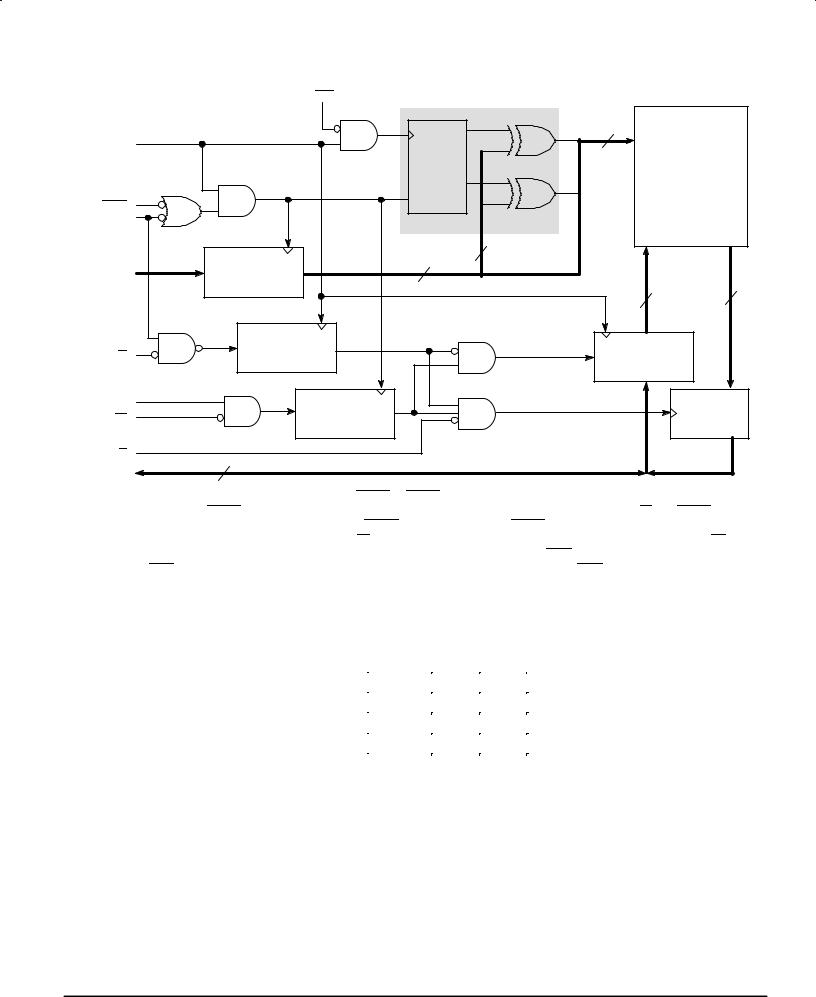Motorola MCM62486BFN11, MCM62486BFN12, MCM62486BFN14 Datasheet

MOTOROLA
SEMICONDUCTOR TECHNICAL DATA
Order this document by MCM62486B/D
32K x 9 Bit BurstRAM
Synchronous Static RAM
With Burst Counter and Self±Timed Write
The MCM62486B is a 294,912 bit synchronous static random access memory designed to provide a burstable, high±performance, secondary cache for the i486 and Pentium microprocessors. It is organized as 32,768 words of 9 bits, fabricated with Motorola's high±performance silicon±gate CMOS technology. The device integrates input registers, a 2±bit counter, high speed SRAM, and high drive capability outputs onto a single monolithic circuit for reduced parts count implementation of cache data RAM applications. Synchronous design allows precise cycle control with the use of an external clock (K). CMOS circuitry reduces the overall power consumption of the integrated functions for greater reliability.
Addresses (A0 ± A14), data inputs (D0 ± D8), and all control signals except output enable (G) are clock (K) controlled through positive±edge±triggered noninverting registers.
Bursts can be initiated with either address status processor (ADSP) or address
status cache controller (ADSC) input pins. Subsequent burst addresses can be generated internally by the MCM62486B (burst sequence imitates that of the
i486 and Pentium) and controlled by the burst address advance (ADV) input pin. The following pages provide more detailed information on burst controls.
Write cycles are internally self±timed and are initiated by the rising edge of the clock (K) input. This feature eliminates complex off±chip write pulse generation and provides increased flexibility for incoming signals.
The MCM62486B will be available in a 44±pin plastic leaded chip carrier (PLCC). Multiple power and ground pins have been utilized to minimize effects induced by output noise. Separate power and ground pins have been employed for DQ0 ± DQ8 to allow user±controlled output levels of 5 volts or 3.3 volts.
•Single 5 V ± 10% Power Supply (± 5% for MCM62486BFN11)
•Choice of 5 V or 3.3 V ± 10% Power Supplies for Output Level Compatibility
•Fast Access Times:11/12/14/19 ns Max and Cycle Times:15/20/25 ns Min
•Internal Input Registers (Address, Data, Control)
•Internally Self±Timed Write Cycle
•ADSP, ADSC, and ADV Burst Control Pins
•Asynchronous Output Enable Controlled Three±State Outputs
•Common Data Inputs and Data Outputs
•High Output Drive Capability: 85 pF per I/O
•High Board Density PLCC Package
•Fully TTL±Compatible
•Active High and Low Chip Select Inputs for Easy Depth Expansion
MCM62486B
FN PACKAGE 44±LEAD PLCC CASE 777±01
PIN ASSIGNMENT
|
A1 |
A0 ADV |
ADSC |
ADSP |
K |
V |
A7 A8 |
A9 |
A10 |
|
|||
|
|
|
|
|
|
|
|
CC |
|
|
|
|
|
|
|
|
|
|
|
|
|
|
|||||
|
6 |
5 |
4 |
3 |
2 |
1 |
44 43 42 41 40 |
A11 |
|||||
A2 |
7 |
|
|
|
|
|
|
|
|
|
|
39 |
|
A3 |
8 |
|
|
|
|
|
|
|
|
|
|
38 |
A12 |
A4 |
9 |
|
|
|
|
|
|
|
|
|
|
37 |
A13 |
A5 |
10 |
|
|
|
|
|
|
|
|
|
|
36 |
A14 |
A6 |
11 |
|
|
|
|
|
|
|
|
|
|
35 |
VSS |
VSS |
12 |
|
|
|
|
|
|
|
|
|
|
34 |
DQ7 |
DQ0 |
13 |
|
|
|
|
|
|
|
|
|
|
33 |
DQ6 |
DQ1 |
14 |
|
|
|
|
|
|
|
|
|
|
32 |
VSSQ |
VSSQ |
15 |
|
|
|
|
|
|
|
|
|
|
31 |
VCCQ |
VCCQ |
16 |
|
|
|
|
|
|
|
|
|
|
30 |
DQ5 |
DQ2 |
17 |
|
|
|
|
|
|
|
|
|
|
29 |
DQ4 |
|
18 19 20 21 22 23 24 25 26 |
27 28 |
|
||||||||||
|
DQ3 |
SSQ |
SS |
|
|
CC |
SS |
|
|
|
|
SSQ |
|
|
|
|
|
|
|
|
|
||||||
|
|
|
G |
S0 S1 |
DQ8 |
|
|||||||
|
V |
V |
|
W V |
V |
V |
|
||||||
|
|
|
|
|
|
|
|
|
|
PIN NAMES |
|
|
|
|
|
|
|
|
|
|
|
|
A0 ± A14 . . . . |
. . . . . . . . . . . . Address Inputs |
||||||||
|
K . . . . . . . . . . . . |
. . . . . . . . . . . . . . . . . . . Clock |
||||||||
|
|
|
|
|
|
|
|
|
|
Write Enable |
|
W |
|||||||||
|
G |
. |
. |
. |
|
. |
. . . . . |
. . |
. . . . . . . . . . . Output Enable |
|
|
S0, |
S1 |
|
. . . . . |
. . |
. . . . . . . . . . . . . Chip Selects |
||||
|
ADV |
. |
. |
. . . . . |
. . |
. . . Burst Address Advance |
||||
|
ADSP, |
|
ADSC |
. |
. . . . . . . . . . . Address Status |
|||||
|
DQ0 ± DQ8 . . . |
. . . . . . . . Data Input/Output |
||||||||
|
VCC . . . . . . . . . |
. . . . . . . + 5 V Power Supply |
||||||||
|
VCCQ . . . . . . . |
Output Buffer Power Supply |
||||||||
|
VSS . . . . . . . . . |
. . . . . . . . . . . . . . . . . Ground |
||||||||
|
VSSQ . . . . . . . |
. . . . . Output Buffer Ground |
||||||||
All power supply and ground pins must be connected for proper operation of the device. VCC ≥ VCCQ at all times including power up.
BurstRAM is a trademark of Motorola, Inc. i486 and Pentium are trademarks of Intel Corp.
REV 2 5/95
Motorola, Inc. 1994

|
|
BLOCK DIAGRAM (See Note) |
|
|
|
|
|
|
ADV |
BURST LOGIC |
|
|
|
|
|
|
|
|
INTERNAL |
|
|
|
|
Q0 |
A0′ |
ADDRESS |
|
|
|
|
|
|
|
|
K |
|
BINARY COUNTER |
A0 |
A1′ |
|
ARRAY |
|
|
Q1 |
|
|||
|
|
|
|
|
15 |
32K x 9 |
|
|
|
|
|
|
MEMORY |
ADSC |
|
CLR |
A1 |
|
|
|
|
|
|
|
|
|
|
ADSP |
|
|
|
|
|
|
|
|
|
2 |
|
|
|
|
ADDRESS |
A1 ± A0 |
|
|
|
|
A0 ± A14 |
15 |
A2 ± A14 |
|
|
|
|
REGISTER |
|
|
|
|
9 |
|
|
|
|
|
9 |
||
|
|
|
|
|
||
|
WRITE |
|
|
|
DATA±IN |
|
W |
REGISTER |
|
|
|
|
|
|
|
|
REGISTERS |
|
||
|
|
|
|
|
|
|
S0 |
|
ENABLE |
|
|
|
OUTPUT |
S1 |
|
REGISTER |
|
|
|
BUFFER |
G |
9 |
|
|
|
|
|
DQ0 ± DQ8 |
|
|
|
|
|
|
|
|
|
|
|
|
|
NOTE: All registers are positive±edge triggered. The ADSC or ADSP signals control the duration of the burst and the start of the next burst. When ADSP is sampled low, any ongoing burst is interrupted and a read (independent of W and ADSC) is performed using the new external address. When ADSC is sampled low (and ADSP is sampled high), any ongoing burst is interrupted and a read or write (dependent on W) is performed using the new external address. Chip selects (S0, S1) are sampled only when a new base address is loaded. After the first cycle of the burst, ADV controls subsequent burst cycles. When ADV is sampled low, the internal address is advanced prior to the operation. When ADV is sampled high, the internal address is not advanced, thus inserting a wait state into the burst sequence accesses. Upon completion of a burst, the address will wrap around to its initial state. See BURST SEQUENCE TABLE.
BURST SEQUENCE TABLE (See Note)
External Address |
A14 ± A2 |
|
A1 |
A0 |
|||
|
|
|
|
|
|
|
|
1st Burst Address |
A14 ± A2 |
|
A1 |
|
|
|
|
A0 |
|||||||
|
|
|
|
|
|
||
2nd Burst Address |
A14 ± A2 |
|
|
|
A0 |
||
|
A1 |
||||||
|
|
|
|
|
|||
3rd Burst Address |
A14 ± A2 |
|
|
|
|
|
|
|
A1 |
A0 |
|||||
|
|
|
|
|
|
|
|
NOTE: The burst wraps around to its initial state upon completion.
MCM62486B |
MOTOROLA FAST SRAM |
2 |
|

SYNCHRONOUS TRUTH TABLE (See Notes 1, 2, 3, and 4)
|
|
|
|
|
|
|
|
|
|
|
|
|
|
|
|
S |
|
ADSP |
|
|
ADSC |
|
|
ADV |
|
|
W |
K |
Address Used |
Operation |
|
|
|
|
|
|
|
|
|
|
|
|
|
|
|
|
|
F |
|
L |
|
|
X |
|
|
X |
|
|
X |
L±H |
N/A |
Deselected |
|
|
|
|
|
|
|
|
|
|
|
|
|
|
|
|
|
F |
|
X |
|
|
L |
|
|
X |
|
|
X |
L±H |
N/A |
Deselected |
|
|
|
|
|
|
|
|
|
|
|
|
|
|
|
|
|
T |
|
L |
|
|
X |
|
|
X |
|
|
X |
L±H |
External Address |
Read Cycle, Begin Burst |
|
|
|
|
|
|
|
|
|
|
|
|
|
|
|
|
|
T |
|
H |
|
|
L |
|
|
X |
|
|
L |
L±H |
External Address |
Write Cycle, Begin Burst |
|
|
|
|
|
|
|
|
|
|
|
|
|
|
|
|
|
T |
|
H |
|
|
L |
|
|
X |
|
|
H |
L±H |
External Address |
Read Cycle, Begin Burst |
|
|
|
|
|
|
|
|
|
|
|
|
|
|
|
|
|
X |
|
H |
|
|
H |
|
|
L |
|
|
L |
L±H |
Next Address |
Write Cycle, Continue Burst |
|
|
|
|
|
|
|
|
|
|
|
|
|
|
|
|
|
X |
|
H |
|
|
H |
|
|
L |
|
|
H |
L±H |
Next Address |
Read Cycle, Continue Burst |
|
|
|
|
|
|
|
|
|
|
|
|
|
|
|
|
|
X |
|
H |
|
|
H |
|
|
H |
|
|
L |
L±H |
Current Address |
Write Cycle, Suspend Burst |
|
|
|
|
|
|
|
|
|
|
|
|
|
|
|
|
|
X |
|
H |
|
|
H |
|
|
H |
|
|
H |
L±H |
Current Address |
Read Cycle, Suspend Burst |
|
|
|
|
|
|
|
|
|
|
|
|
|
|
|
|
|
NOTES:
1.X means Don't Care.
2.All inputs except G must meet setup and hold times for the low±to±high transition of clock (K).
3.S represents S0 and S1. T implies S1 = L and S0 = H; F implies S1 = H or S0 = L.
4.Wait states are inserted by suspending burst.
ASYNCHRONOUS TRUTH TABLE (See Notes 1 and 2)
Operation |
|
|
|
|
|
G |
|
I/O Status |
|
|
|
|
|
|
Read |
|
L |
|
Data Out (DQ0 ± DQ8) |
|
|
|
|
|
Read |
|
H |
|
High±Z |
|
|
|
|
|
Write |
|
X |
|
High±Z Ð Data In (DQ0 ± DQ8) |
|
|
|
|
|
Deselected |
|
X |
|
High±Z |
|
|
|
|
|
NOTES:
1.X means Don't Care.
2.For a write operation following a read operation, G must be high before the input data required setup time and held high through the input data hold time.
ABSOLUTE MAXIMUM RATINGS (Voltages Referenced to VSS = 0)
Rating |
Symbol |
Value |
Unit |
|
|
|
|
Power Supply Voltage |
VCC |
± 0.5 to 7.0 |
V |
Output Power Supply Voltage |
VCCQ |
± 0.5 to VCC |
V |
Voltage Relative to VSS |
Vin, Vout |
± 0.5 to VCC + 0.5 |
V |
Output Current (per I/O) |
Iout |
± 20 |
mA |
Power Dissipation |
PD |
1.0 |
W |
Temperature Under Bias |
Tbias |
± 10 to + 85 |
°C |
Operating Temperature |
TA |
0 to + 70 |
°C |
Storage Temperature |
Tstg |
± 55 to + 125 |
°C |
NOTE: Permanent device damage may occur if ABSOLUTE MAXIMUM RATINGS are exceeded. Functional operation should be restricted to RECOMMENDED OPERATING CONDITIONS. Exposure to higher than recommended voltages for extended periods of time could affect device reliability.
This device contains circuitry to protect the inputs against damage due to high static voltages or electric fields; however, it is advised that normal precautions be taken to avoid application of any voltage higher than maximum rated voltages to this high±impedance circuit.
This CMOS memory circuit has been designed to meet the dc and ac specifications shown in the tables, after thermal equilibrium has been established.
MOTOROLA FAST SRAM |
MCM62486B |
|
3 |

DC OPERATING CONDITIONS AND CHARACTERISTICS
(VCC, VCCQ = 5.0 V ± 5%, TA = 0 to + 70°C, for device MCM62486B±11)
(VCC = 5.0 V ± 10%, VCCQ = 5.0 V or 3.3 V ± 10%, TA = 0 to + 70°C, for all other devices)
RECOMMENDED OPERATING CONDITIONS (Voltages referenced to VSS = 0 V)
|
|
|
|
|
|
|
|
|
|
Parameter |
Symbol |
|
Min |
Max |
Unit |
|
|
|
|
|
|
|
|
|
|
|
|
|
|
|
|
Supply Voltage (Operating Voltage Range) |
VCC |
4.5 |
5.5 |
V |
|||||||||||
Output Buffer Supply Voltage |
VCCQ |
|
|
|
V |
||||||||||
(5.0 V TTL Compatible) |
|
4.5 |
5.5 |
|
|||||||||||
(3.3 V 50 Ω Compatible) |
|
3.0 |
3.6 |
|
|||||||||||
|
|
|
|
|
|
|
|
|
|
|
|
|
|
|
|
Input High Voltage |
VIH |
2.2 |
VCC + 0.3 |
V |
|||||||||||
Input Low Voltage |
VIL |
± 0.5* |
0.8 |
V |
|||||||||||
* VIL (min) = ± 3.0 V ac (pulse width ≤ 20 ns) |
|
|
|
|
|
||||||||||
DC CHARACTERISTICS |
|
|
|
|
|
||||||||||
|
|
|
|
|
|
|
|
|
|
|
|
|
|
|
|
|
|
|
|
|
|
|
|
|
|
Parameter |
Symbol |
|
Min |
Max |
Unit |
|
|
|
|
|
|
|
|
|
|
|
|
|
|
|
|
Input Leakage Current (All Inputs, Vin = 0 to VCC) |
Ilkg(I) |
|
Ð |
± 1.0 |
μA |
||||||||||
Output Leakage Current |
|
|
|
|
= VIH, S0 = VIL, Vout = 0 to VCCQ) |
Ilkg(O) |
|
Ð |
± 1.0 |
μA |
|||||
(G, |
S1 |
|
|||||||||||||
AC Supply Current |
|
|
|
|
= VIL, S0 = VIH, All Inputs = VIL = 0.0 V and VIH ≥ 3.0 V, |
ICCA |
|
Ð |
160 |
mA |
|||||
(G, |
S1 |
|
|||||||||||||
Iout = 0 mA, Cycle Time ≥ tKHKH min) |
|
|
|
|
|
||||||||||
Standby Current |
|
|
= VIH, S0 = VIL, All Inputs = VIL and VIH, Cycle Time ≥ tKHKH min) |
ISB1 |
|
Ð |
50 |
mA |
|||||||
(S1 |
|
||||||||||||||
Output Low Voltage (IOL = + 8.0 mA) |
VOL |
|
Ð |
0.4 |
V |
||||||||||
Output High Voltage (IOH = ± 4.0 mA) |
VOH |
|
2.4 |
Ð |
V |
||||||||||
NOTE: Good decoupling of the local power supply should always be used. DC characteristics are guaranteed for all possible i486 and Pentium bus cycles.
CAPACITANCE (f = 1.0 MHz, dV = 3.0 V, TA = 25°C, Periodically Sampled Rather Than 100% Tested)
Characteristic |
Symbol |
Typ |
Max |
Unit |
|
|
|
|
|
Input Capacitance (All Pins Except DQ0 ± DQ8) |
Cin |
2 |
3 |
pF |
Input/Output Capacitance (DQ0 ± DQ8) |
CI/O |
7 |
8 |
pF |
MCM62486B |
MOTOROLA FAST SRAM |
4 |
|
